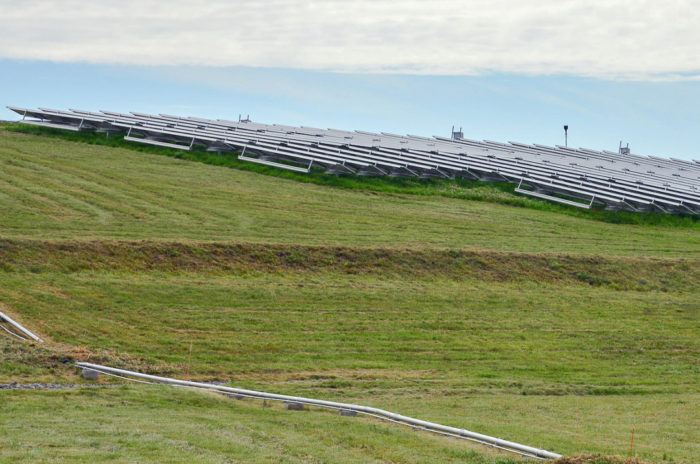
Image Credit: Massachusetts Department of Environmental Protection / CC BY 2.0 / Flickr
Closed landfills, even former Superfund sites, are becoming fair game for developers who use them for projects ranging from residential and commercial developments to solar farms.
There are technical challenges, to be sure — settling terrain as buried refuse breaks down, gases given off by the site, and liquid wastes that leach out of the ground — but once engineers find ways around those problems, the landfills can offer new acreage in areas where open space is hard to find.
Related Companies, for example, recently won unanimous approval from the Santa Clara, California, City Council for a $6 billion mixed-use development on 40 acres of the city’s landfill, Construction Dive reports. The retail and residential village is part of the 240-acre CityPlace proposed by Related. When complete, CityPlace would include 5.7 million square feet of offices, 1.1 million square feet of retail space, 700 hotel rooms, and 1,360 apartments — the largest private development in Silicon Valley history.
Construction could start late in 2017, providing that Related gets the remaining permits it needs.
Building high-end projects over old dumps may seem counterintuitive, but there’s nothing unusual about it, says New York attorney Dennis Toft.
“Everyone is afraid of the unknown, but, on the flipside, you have these large tracts of land — frequently owned by municipalities or by people who are no longer managing them — that can be very attractive for redevelopment,” he told Construction Dive.
Sites present many challenges
From a sustainable building standpoint, former landfills are ideal sites for new development because they recycle land that’s already been used and allow undeveloped property in the area to stay undeveloped. Still, builders have to solve some difficult engineering problems to make the projects work.
One problem is the inherent instability of the ground. As waste decomposes, the ground can settle. If the project atop the landfill is a golf course, that’s not a big problem. But if the developer is putting up office buildings or apartments, engineers must find ways to stabilize the area. The Silicon Valley Business Journal reports that Related’s Santa Clara project includes construction of an enormous platform over the landfill. Developers will drive deep pilings to support the platform.
The fluid that trickles out of a landfill — that is, the leachate — often carries contaminants with it. These contaminants can spoil both the soil and the groundwater. Decomposing garbage also creates gases that seep out of the soil, and these gases can be trapped by a building’s foundation. Developers sometimes have to install a permeable layer of gravel to channel gases away from a building, or install a membrane beneath the building to keep gases out of living spaces.
These problems, however, are not insurmountable. Anna Amarandos, who is working on site preparation for the Santa Clara project, told Construction Dive that clients involved in developments of this kind are used to the lengthy timelines that permitting and construction take. “Some of my clients are pretty experienced with complex projects like these,” she said, “and they don’t scare easily.”
Solar also makes a good post-landfill tenant
Potential exposure to toxic water or gases can make regulators nervous about building residential projects atop old landfills. Investor uncertainty about building solar farms on old landfills can be an obstacle to solar development as well, SunEdison’s Thomas Leyden told Construction Dive.
Still, the idea is proving very appealing. A website called Waste 360 lists proposed or completed photovoltaic (PV) projects in South Carolina, New York, Massachusetts, New Jersey, North Carolina, and Connecticut.
The Boston Globe reports that a federal Superfund site in Billerica, Massachusetts, is now the home of a 6-megawatt PV project. Urban Green Technologies completed the project on 40 acres of the old Shaffer landfill two years ago.
The station includes 20,000 PV modules that make enough electricity for about 1,200 homes. The company will pay the town nearly $3 million over 25 years in lieu of taxes, in addition to paying $400,000 in back taxes on the site.
“It was a complicated deal to negotiate … several parties were involved,” Town Manager John C. Curran told The Globe. “But the end result is the town is going to realize tax revenue on a site that was previously tax-delinquent and generating no tax revenue for decades.”
Projects don’t have to be huge to succeed. Belfast, Maine, for example, became the first community in the state to use a capped landfill for a solar farm when it opened a solar farm facility earlier this year on a 10-acre landfill that closed in 1993. It’s rated at 122 kilowatts — not much by Billerica’s standards, but still enough to generate about $20,000 worth of electricity per year, a 20% offset for the town’s electric bill.
Weekly Newsletter
Get building science and energy efficiency advice, plus special offers, in your inbox.












2 Comments
Capturing the gas to use as fuel is worth mentioning.
BMW Manufacturing (Greer SC) has been using methane from a landfill for power generation and conversion to hydrogen for over a decade.
I don't see why residents wouldn't be able to do the same.
Love Canal
New parks or solar fields built on old dumps, maybe. Residential, commercial, or schools? Not so bright. This is what happens when communities rely on property taxes for revenue, and when developers (and their local enablers) don’t care about the future. This is reminiscent of the Love Canal, where twice (TWICE!) they allowed development on top of a known toxic waste site, with disastrous results.
Log in or create an account to post a comment.
Sign up Log in